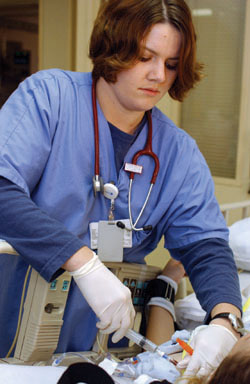
Olivia Barnes, R.N., flushes a central line on a patient in the MICU. Photo by Dana Johnson
MICU reduces hospital- acquired infection rates
In a textbook example of how standardization of care can improve clinical outcomes, the medical intensive care unit at Vanderbilt University Hospital has dramatically reduced the occurrence of blood stream infection in patients with central intravenous lines.
Along with more than 300 other acute care hospitals, VUH tracks hospital acquired infections among its patients according to protocols set out by the National Nosocomial Infection Surveillance system (NNIS) of the Centers for Disease Control and Prevention (CDC). One of the system’s ongoing studies concerns blood stream infection in adult medical intensive care patients with central lines. Nationally about 50 percent of MICU patients have a central line inserted during admission, and the CDC estimates there are 80,000 central-line-associated blood stream infections per year at a treatment cost of $34,000 to $50,000 each.
VUMC Infection Control Practitioner Kathie T. Wilkerson said that after standardizing training and documentation for the procedure and giving reports about their process and the infection rates associated with their practice to the resident physicians and nurses who insert the lines, the MICU moved from the middle of the NNIS pack to among the top 10 percent of medical intensive care units in prevention of central-line-associated blood stream infections.
The program to standardize insertion of central lines was designed and initiated in fall 2002 by VUMC Quality Scholar Dr. Richard “Brick” Wall (who has since moved on to the University of Washington). Wilkerson and Julie Foss, manager of the MICU and the third-floor round wing, said Wall’s program has been successful because it was designed above all to have permanence in the day-to-day work of the team in the MICU.
MICU nurses and residents all undergo the same training for insertion of central lines, working with a computerized training module developed by Wall.
Doctors on the MICU don’t insert a central line without the assistance of extra hands to help maintain an adequately uncontaminated field for this bedside procedure. When residents arrive on monthly rotation, Foss presents the unit’s latest data on hospital -acquired infection and central-line insertion processes, and halfway through the month the data is updated and presented again.
Foss and Wilkerson said leaders in other VUH intensive care units have become interested in adapting the program. They said the next step of the project in the MICU will be greater standardization of central-line maintenance.













